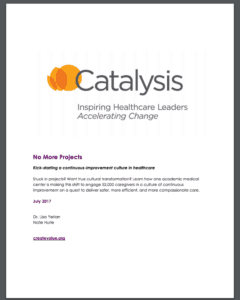 I really enjoyed and appreciated this new white paper that was written by Dr. Lisa Yerian and Nate Hurle from The Cleveland Clinic:
I really enjoyed and appreciated this new white paper that was written by Dr. Lisa Yerian and Nate Hurle from The Cleveland Clinic:
“No More Projects: Kick-starting a continuous-improvement culture in healthcare“
The paper was published by Catalysis and is available through them (free registration required).
Note: I am a faculty member for Catalysis, a non-profit organization. Join me in Florida this November when I teach my “Better Metrics” workshop as part of their workshop series.
Before sharing some highlights from the paper, I'll share a link to the podcast that I did with Lisa and Nate:
Podcast #282 – Lisa Yerian, MD & Nate Hurle from Cleveland Clinic on Lean
And you can find other blog posts I've written about visits to the Clinic.
The Paper
The title of the paper, “No More Projects” points to Cleveland Clinic shifting from a reliance on big improvement projects to their aim of a culture of continuous improvement.
I'd suggest that instead of saying “no more projects,” the mindset should be “more than projects.” There's a time and a place for formal projects, A3s, Rapid Improvement Events, and the like. Some big challenges require that format.
That said, we can ALSO work to engage everybody in continuous improvement on a daily basis. It's either/or, it's AND. It all fits together. You can have lots of small “PDSA cycles” (daily improvement), a handful of “A3s” being used for problem solving, and a few larger PDSA cycles (projects) happening at once. You can engage people in different ways.
Their realization and goal at Cleveland Clinic:
I love the message of the paper, which includes:
- “Focus on what matters”
- Standardizing for the right reasons (“highest quality, most compassionate, and lower cost care”)
- Improvements “being led and sustained by the people doing the work”
- The projects approach works, but it has limitations
- Starting with problems that need to be solved and start with purpose
- Building problem solving capabilities in care givers
- Start with a “model area”
- Be patient
- “The internal CI team does not have all the answers”
- You have to engage “hearts and minds”
The article ends with their five key lessons learned. Go check it out.
I also appreciated that they used run charts to illustrate improvement data rather than simple before-and-after comparisons (something I've blogged about before here and here):
And the white paper includes a link to this playlist of YouTube videos:
I shared the paper with some people who work in other healthcare organizations and this was one reaction:
Mark, this paper is perfect for helping us make the case here for the 2018 plans I'm proposing to move from projects to getting all staff more involved and capable of engaging in small improvements every day. I might try to build on one area which is doing extremely well with their new idea board huddle, using them as a “model area” as the paper suggests.
Thanks to Lisa, Nate, and Catalysis for the paper!
Please scroll down (or click) to post a comment. Connect with me on LinkedIn.
Let’s build a culture of continuous improvement and psychological safety—together. If you're a leader aiming for lasting change (not just more projects), I help organizations:
- Engage people at all levels in sustainable improvement
- Shift from fear of mistakes to learning from them
- Apply Lean thinking in practical, people-centered ways
Interested in coaching or a keynote talk? Let’s talk.
Join me for a Lean Healthcare Accelerator Trip to Japan! Learn More












Comment from LinkedIn:
Anne Bobb:
Mark, thanks for sharing. I believe the combination of everyone working on small improvements plus a few big ones is the only approach that will lead to true transformation. I hope the white paper will give me some good ideas for operationalizing the “continuous small improvements” part. Lots of barriers to overcome!
Hi Mark – great point and suggestion for “More than projects.” Indeed we still do have focused projects, and teach teams to work through their own A3 following John Shook’s Managing to Learn. A big difference in this is that we use to really own these A3 projects, now that ownership resides with the process owners and we are teaching them how to work through those challenges.
Another key point I took away from the article is using “pull” rather than pushing to spread improvement across your organization, focusing on the benefits or results (vs. methods) when talking with new target areas for spreading. Great article, which I’ve shared here at Franciscan Children’s, great work Cleveland Clinic — thanks for sharing it Mark.
Thanks, Tom! We found that the benefits definitely get people excited and emotionally invested. It’s hard to get people emotionally invested in the methods alone – they’re just the “how” … Sometimes we are asked if we have an organizational mandate. We don’t have a mandate. We have thousands of caregivers at all levels (executive to front-line and including physicians) “pulling” – which I believe is MUCH more powerful than a mandate.
Comments are closed.